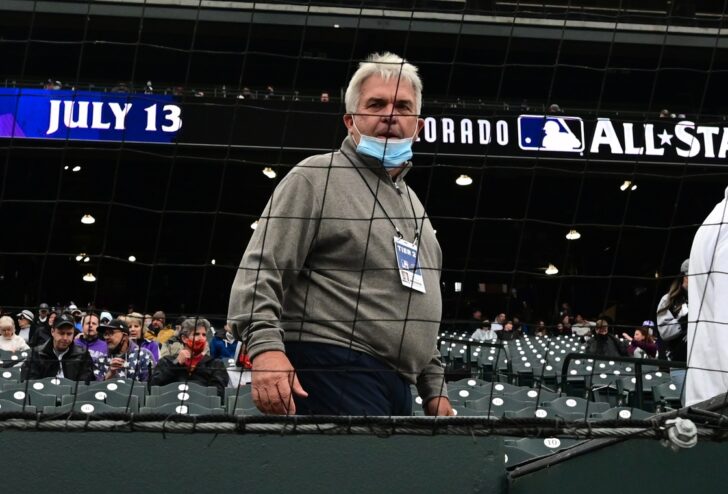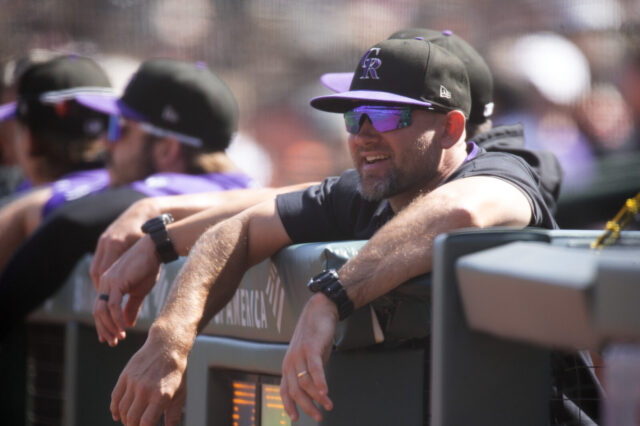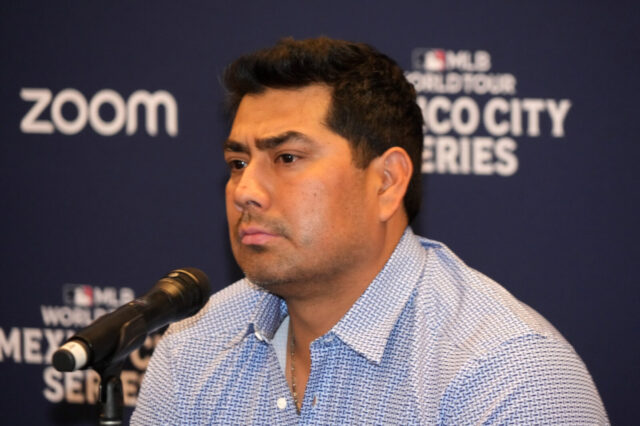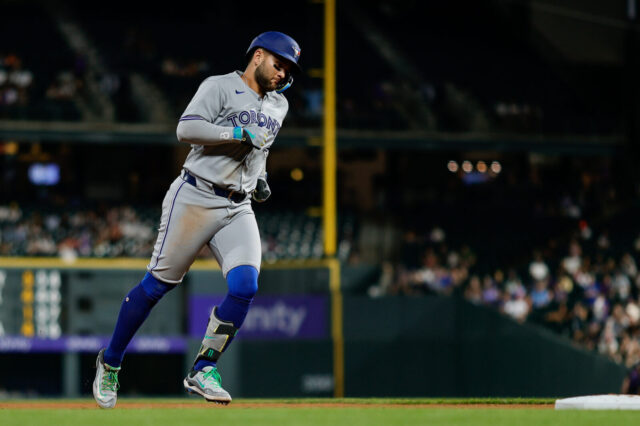The Colorado Rockies lost 103 games in 2023, the worst mark in franchise history, and rated pretty poorly across the board in just about every single category.
It was, by several measures, the worst campaign the club has ever put together.
By team OPS+ (83) it was the second worst offense in franchise history after the shortened 2020 season and by ERA+ (89) it was the third worst season in franchise history after 1993 and 2014.
So, you can go ahead and just give the offense and pitching and “F” for the year and move on.
There were some bright spots, to be sure. Nolan Jones put up superstar numbers seemingly out of nowhere. Three players, including two rookies, were nominated for Gold Gloves. And despite missing a decent chunk of the season, franchise icon Charlie Blackmon provided some memorable moments.
But, for anyone looking at the long-term outlook of this club – and for anyone who was being honest with themselves on day one of Spring Training – the possibility of a 100-loss season was always more likely than a trip to Rocktober.
Whether the owner was willing to admit it or not, this year was always going to be about building toward the future and on some level needs to be evaluated as such.
Before we get there, though, we do need to begin our grading of the things that matter right up at the very top.
Ownership: F
For at least the fourth year in a row, Dick Monfort earns an F for continuing to say misguided things and leaving fans feeling enraged or, worse yet, apathetic.
Even putting aside his failures of the last several seasons – allowing the trade of Nolan Arenado chief among them – he put a cloud over 2023 precisely by undercutting what should have been the central message of the season.
When he said just before pitchers and catchers reported that he thought the squad assembled could be a .500 club, he once again put a public onus on his GM and manager to treat this year as though it was any other when it could and should have been about the youth movement from the very beginning.
It also became the go-to quote for anyone not willing to give the team the benefit of the doubt that they truly have started off in a new direction, despite what they did at the trade deadline.
Montfort should get some credit for allowing Bill Schmidt to make those moves but at this point he has a long way to go toward restoring fan trust in his public statements and transparency level when it comes to this team.
General Manager: B+
All that said, it is important to recognize that Schmidt can’t go back in time and un-trade Arenado, a move made by his predecessor that still colors everything this franchise does.
He also can’t undo his own biggest mistake thus far, signing Kris Bryant, but if we are judging him based solely on how he handled his duties from February through October, the Rockies GM actually did pretty well.
The biggest blunder he made on the year was the signing of, and commitment to, Jurickson Profar. Not only was Profar one of the worst qualified hitters and defenders for most of the season, he also took playing time away from some guys who might be vital parts of the team’s future
Even that, though, in the grand scheme, was a one-year deal that doesn’t cost the team anything beyond that development time.
The other veteran acquisitions he made, though, all panned out in subtly savvy ways which may have been the plan for Profar but his performance wouldn’t allow for it. Conversely, Mike Moustakas, Pierce Johnson, and Brad Hand all came aboard, made some solid contributions, and then got flipped for something far more valuable to the Rockies right now, young pitching. Brent Suter also had a nice season at may return at a reasonable price.
Schmidt gets bonus points for sticking with young players through some tough times, most especially Brenton Doyle who spent the vast majority of the season batting below .200 and for speaking honestly with the media in the aftermath of the deadline making it clear that they need more pitching and to build around this new, younger core.
His biggest and best move of the year though was clearly the trade for Nolan Jones who quickly became easily the most productive member of the team.
If he had traded a few more pieces at the deadline, moved on a bit sooner from Profar (or just not signed him in the first place) and maybe gotten a better price for Charlie Blackmon (jury is still out on that one) he could have had an “A” season based on the tasks at hand.
Manager: C-
It can be difficult to tell how culpable a manager is in a season where injuries riddled an already substandard roster. It’s hard to say that a few in-game moves here or there would have led to better results, or if that would even have been more desirable considering the Rockies now have the best chance possible at the first overall draft pick.
It’s fair at this point to question whether or not Bud Black, who tends to lean more heavily on veterans whenever he can, is the right man for the job during this time when the club needs to rely on more unproven players. It’s also fair to look at a trend throughout his career of underperforming offenses.
Probably the biggest issue for this season, though, was the handling of Elehuris Montero who began the year as the Opening Day third baseman. It took less than a month for the club to conclude that his defense at the hot corner just wasn’t good enough and he would need to go back to Triple-A for a change over to first base.
Montero has always hit well in the minors but his leash, even after the position change, seemed unreasonably short and while Ezequiel Tovar and Brenton Doyle were getting the opportunity to work through things, he was not. Instead, Ryan McMahon, who began the season at second, slid over to third to make way for Harold Castro, who put together one of the least memorable campaigns in recent memory.
To be fair, the roster was already lacking in firepower and whether cynics want to hear it or not this team did experience an extreme number of serious injuries this season, most notably with the entire starting rotation spending large segments of time on the IL.
It’s hard to say how much more Black could have gotten out of this specific group of players but it is fair to wonder, despite how much he has meant for the pitching in the past, if he has, or can develop, a mindset that vibes with the Rockies current needs.
Farm System: B
There were a couple of incredibly frustrating setbacks for some top prospects in the Rockies system but other than the injury bug, they had a pretty great year.
Zach Veen (wrist) Gabriel Hughes (Tommy John) and Jordy Vargas (Tommy John) all appeared to be on the fast track before going down, easily the worst news from down on the farm in 2023.
On the opposite end of the spectrum, the club now has five players in MLB Pipeline’s Top 100 Prospects list: Adael Amador (21, IF) Yanquiel Fernandez (49, OF) Chase Dollander (59, SP) Jordan Beck (83, OF) and Veen (92, OF).
Sterlin Thompson (the player the Rockies took with the draft pick they received for Trevor Story) is floating just outside the Top 100 after an impressive year that saw him post a 147 wRC+ in High-A and a 111 wRC+ in Double-A.
Next comes 20-year-old Dyan Jorge who jumps up to the seventh spot on Pipeline’s Rockies Prospect list after a promising stateside debut and he is followed by first-round-pick Benny Montgomery who keeps making the most out of his athleticism.
The ninth player on the list may be the most immediately intriguing as the defensively renowned, switch-hitting catcher Drew Romo simply continues to outperform expectations. He started off slow but made so many strides in Double-A that he earned the promotion to Triple-A and continued to hit well. He is now officially knocking on the door to the big leagues.
Third baseman Warming Bernabel rounds out the Top 10 followed by another switch-hitting catcher and 2023 draft pick, Cole Carrig.
Perhaps the biggest symbol for how much the Rockies farm system has improved though, is that Hunter Goodman still ranks 12th after the season he just put together.
In 129 games across three levels, Goodman hit 35 home runs, drove in 128 runs, and got the game-winning hit in his MLB debut, showcasing a dreamy swing that evokes Josh Donaldson and Justin Turner.
Outside of any individual player, though, the best thing that has happened to the Rockies collection of prospects this year is that they finally have some pitching to speak of.
The position players have quietly been exciting for a few years but these lists have been bereft of quality pitching. After a pair of strong drafts and the five moves made at the deadline, though, there is light at the end of the tunnel.
Pipeline has 14 pitchers in the Rockies Top 30, including five lefties.
Dollander (3) is the only one in the Top 12 but after that comes a slew of intriguing arms.
Sean Sullivan (13) Jack Mahoney (14) Joe Rock (16) Jordy Vargas (17) Gabriel Hughes (18) Jackson Cox (19) Carson Palmquist (21) Mason Albright (22) Jake Madden (23) Victor Vodnik (24) Isaiah Coupet (25) Cade Denton (28) and Jaden Hill (29).
The ever-present caveat with prospects is of course that most of these players won’t ultimately pan out but if even just a few of them do, it could go a long way toward boosting the rebuild.
There is still work to be done here but by every measure the farm system has improved by leaps and bounds since Schmidt took over the GM job.
Given that Jones was, on a game-to-game basis, the most valuable rookie in MLB this season and that both Tovar and Doyle have shown a ton of promise, at least defensively, the Rockies young talent is legitimate.
The next question is whether or not they can build around what they have and maximize it or whether or not this front office will follow in the footsteps of those from the past and end up never achieving sustained success despite all the potential.



